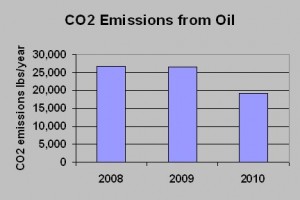House: Built in 2002, 4247 square feet plus 1700 finished basement
System Description: Vacuum tubes on the roof contain copper rods filled with glycol. As the rods heat up from the sun, the glycol boils and bubbles to the top. This heat is then transferred to a separate glycol loop that runs into the basement and preheats water in a large storage tank. The preheated water goes into the existing hot water tank instead of the cold water intake.

To provide supplementary heating, two more storage tanks containing a glycol/water mix are heated up by the excess hot glycol from the roof. Triggered by an independent thermostat, the heated glycol/water mix in these holding tanks is pumped, via a closed loop circuit, through 4 small wall-mounted radiators installed in the most frequently used rooms. The radiators then blow warm air into those rooms.
In the summer, a switch is turned to “summer” mode and the heated-up glycol not needed for hot water in the house runs through tubes to a heat exchanger that heats a swimming pool.
Components: 4 Apricus solar collector arrays each with 30 vacuum tubes on roof, circulation system for solar-heated glycol, storage tanks, wall-mounted radiator units for space heating, pool heat exchanger, fully automatic control system.
System provides: Approximately 70% of hot water, plus supplementary heating
Non-solar heating and hot water system: Oil-fired furnace provides heat and back-up hot water.
Installation: Installed fall 2009 by Renewable Energy Systems (RES Solar), www.ressolar.com, 800 620 4134
Town permits involved: Yes
Price: Hot water system alone would cost $11,500 gross, $6,025 net of rebates. System as installed (with supplementary heat) cost $31,500 gross, $20,025 net
Payback Period: Payback from hot water alone is estimated to be 8 years at current oil prices.
For entire system as configured, payback is approximately 15 years at current prices without considering any benefit from heating the pool (or home appreciation).
Advantages: Supplies majority of hot water used in the house. With more than 2 people living at home the impact would be even greater. Can provide a steady source of warmth throughout the evening in the most used rooms. Completely self-regulating.
Disadvantages: Building inspector required additional supports on roof based on engineer’s specifications. Storage tanks take up space in basement. Radiators are not on independent thermostats and are good for maintaining temperature but not great at increasing temperature in a short period of time. They are also noisy when set to “high”.

